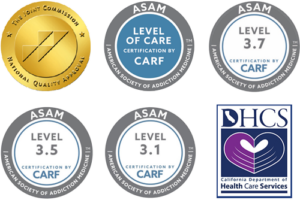What is Gray Area Drinking?
Published on: November 18, 2022 | Updated on: December 10, 2025
“Gray area drinking” is a fairly recent addition to our cultural lexicon. Like anything else described as being in the gray area, gray area drinking (“grey area drinking” to those in the United Kingdom) occupies that middle ground. Still wondering what “gray area drinking” is and whether it applies to you? Keep reading to learn more.
What is Gray Area Drinking?
Those who refer to themselves as gray area drinkers are neither an occasional drinker nor an alcoholic. The National Institute on Alcohol Abuse defines gray area drinkers as those who have a daily habit of drinking in social settings or when at home alone. Even so, they may not show the usual signs of alcohol abuse, and appear to have a grip on their drinking.
Social drinking or solo drinking habits that stand in the “gray area” are referred to as such because these behaviors represent a potential bridge between relatively normal activities or alcohol abuse and alcoholism. Continued behaviors like this are a form of problem drinking and may lead to problematic drinking habits and eventual physical dependency or mental health concerns,
Gray area drinkers are not yet dependent on or addicted to alcohol in a clinical sense, but their drinking could quickly become a problem. They may not be experiencing withdrawal symptoms when they stop drinking, but they are far from being just an occasional drinker.
Taking stock of being in this gray area can provide the person with an opportunity to rethink their drinking habits.
Why Gray Area Drinking Is a Concern
Grey area drinking might seem harmless to many, but it can serve as a bridge between moderate drinking and alcohol use disorder. It is the blurred line between casual drinking and problematic drinking. As alcohol is socially accepted and widely promoted, you may not even realize you’re at risk until it becomes a bigger problem.
5 Signs of Gray Area Drinking
From the outside, you may appear to be fine with no overt signs of having a drinking problem (much like functional alcoholism). While this may be the case at the moment, it changes as the drinking escalates. Some of the signs of gray area drinking include:
- You secretly worry. Even though you don’t acknowledge that you might have a drinking problem, on some level you are concerned about it. You may begin to worry about how others perceive your drinking behavior, or that you could be slipping into alcoholism.
- On and off drinking. Every so often you say you’ve had enough and swear off alcohol. You truly intend to stop drinking and even make plans for a healthy new diet and fitness routine. But you find you don’t stay sober for long. As soon as a new challenge arises, such as a relationship problem or money troubles, you pick up your drinking again.
- You use alcohol as a tool. You may rely on the effects of alcohol to help you relax in social situations. Maybe you reward yourself with alcohol after a long day at work. Perhaps you use alcohol to numb the feelings of depression. You are using alcohol as a tool to fix something in your life.
- You break your own rules. On some level, you realize you need to impose some restrictions on your drinking habits. You may restrict your drinking to weekends, or you may set a limit of having only one drink, for instance. While this is a noble attempt to control drinking, you usually find yourself breaking these rules.
- You experience adverse effects. You worry about the effects of your drinking, things that others may not be aware of. These might include binge drinking sessions, hangovers, sleepless nights, or waking up with regrets about the night before.
As with any ongoing substance use, the gray area drinker will see their tolerance increase at some point. Chronic exposure to alcohol always has this effect on the brain. Someone engaged in grey area drinking has an opportunity to make needed changes before the disease of addiction develops.
Gray Area vs. Binge Drinking
While gray area drinking is more about the frequency and dependency on alcohol in daily life, binge drinking is defined as consuming a large quantity of alcohol in a short period of time. It’s crucial to understand the difference: both can lead to harmful consequences but may require different approaches to address.
The Societal Influence on Grey Area Drinking
Our society often promotes the idea of “drinking away your problems” or using alcohol as a way to “unwind.” Happy hours, brunch mimosas, and wine nights have become deeply ingrained in many cultures. While these events are often innocuous, they can make it challenging for individuals to recognize when their drinking habits are no longer just for leisure.
Understanding Your Relationship with Alcohol Consumption
If you’re a gray area drinker, examining your relationship with alcohol is vital in preventing alcohol use disorder. Ask yourself questions like:
- Do I drink out of habit or choice?
- Do I feel uncomfortable in social situations without alcohol?
- Do I rely on alcohol to handle stress or sadness?
Reflecting on these questions can provide clarity on where you stand in the spectrum of gray area drinking.
Drinking Habits: Signs of Alcohol Use Disorder
For someone who ignores the warning signs and continues gray area drinking or any other type of problematic drinking, an alcohol use disorder may result. What may have started as a simple glass of wine to help you fall asleep at night morphed into two glasses, and then three. As consumption increases, the brain makes adjustments, and dependency often develops.
Grey area drinkers will recognize the warning signs of an alcohol use disorder, which include:
- Ended up drinking more or for longer than you intended.
- Wanted to stop or cut back on drinking, but couldn’t.
- Spent a lot of time drinking or recovering from drinking.
- Obsessing over alcohol and looking forward to drinking.
- Found your drinking interfered with family or work obligations.
- Kept drinking even though it was causing adverse effects in your life.
- Traded of your prior hobbies and interests to drink instead.
- Your drinking led to high-risk behaviors.
- Found yourself needing to drink ever more alcohol to achieve desired effects.
- Had withdrawal symptoms when the effects of alcohol wore off.
The more of these signs you identify with, the more severe your alcohol problem is. In fact, gray area drinking may have already begun to cross over into a severe alcohol use disorder.
Tolls on Physical Health
Social drinking, when kept moderate, typically doesn’t have significant negative health effects. However, when social drinking becomes more frequent or problematic — crossing from grey area drinking to into a moderate or severe alcohol use disorder, it can lead to several physical health concerns. Here are the primary health effects associated with problematic or excessive social drinking:
1. Liver Damage
- Fatty liver: Early stage of alcohol-related liver damage where fat accumulates in liver cells.
- Hepatitis: Chronic drinking can cause inflammation of the liver.
- Cirrhosis: Long-term alcohol abuse can lead to irreversible scarring and damage to liver tissues.
2. Cardiovascular Issues
- High blood pressure: Alcohol raises blood pressure, which can increase the risk of heart disease.
- Cardiomyopathy: Excessive drinking weakens the heart muscle, making it less efficient at pumping blood.
- Irregular heartbeat (arrhythmia): Alcohol can trigger abnormal heart rhythms, sometimes leading to life-threatening situations.
- Stroke: Heavy drinking increases the risk of both ischemic and hemorrhagic stroke.
3. Digestive System Damage
- Gastritis and ulcers: Alcohol irritates the stomach lining, leading to inflammation and ulcers.
- Pancreatitis: Chronic drinking can lead to inflammation of the pancreas, causing digestive problems and pain.
- Malnutrition: Alcohol inhibits the absorption of nutrients in the intestines, leading to deficiencies, especially in B vitamins.
4. Weakened Immune System
- Excessive drinking weakens the immune system, making individuals more susceptible to infections, such as pneumonia and tuberculosis.
5. Weight Gain and Obesity
- Alcohol contains empty calories, contributing to weight gain. High-calorie alcoholic beverages can lead to obesity and metabolic disorders if consumed regularly.
6. Increased Cancer Risk
- Drinking alcohol, especially in large amounts over time, increases the risk of various cancers, including cancers of the mouth, throat, esophagus, liver, breast, and colon.
7. Brain and Cognitive Impairment
- Memory loss: Excessive drinking impairs short- and long-term memory.
- Cognitive decline: Over time, heavy drinking can lead to cognitive deficits, making learning and decision-making more difficult.
- Wernicke-Korsakoff syndrome: Chronic alcohol abuse can lead to a serious deficiency of vitamin B1 (thiamine), resulting in this brain disorder characterized by confusion, memory problems, and impaired motor coordination.
8. Alcohol Dependency and Withdrawal
- Tolerance and dependency: As drinking becomes more frequent, the body builds a tolerance, which can lead to dependency.
- Withdrawal symptoms: When someone with a dependency tries to cut back or quit, they may experience withdrawal symptoms, including shaking, sweating, nausea, seizures, and delirium tremens (severe confusion and tremors).
9. Hormonal Imbalance
- Alcohol disrupts hormone regulation, which can lead to issues like decreased testosterone levels in men, contributing to fertility problems, and changes in estrogen levels, which may increase breast cancer risk in women.
10. Sleep Disorders
- Although alcohol can initially make you feel drowsy, it disrupts sleep patterns, leading to poor-quality sleep, insomnia, and fatigue.
11. Increased Risk of Accidents and Injuries
- Excessive social drinking increases the likelihood of accidents, falls, and injuries due to impaired judgment, coordination, and reaction times.
While occasional or moderate social drinking is unlikely to cause major health problems, it’s important to monitor the frequency and amount consumed to prevent these potentially severe physical health effects. How much alcohol consumption a person must do depends on numerous factors; three drinks or four drinks a night may be relatively normal for some people, but others may develop an alcohol dependence or eventual sever alcohol problems. Again, gray area drinking doesn’t mean you’ve hit rock bottom, but the warning signs are there.
How To Stop Gray Area Drinking And Avoid Alcohol Abuse
If you are becoming aware of the dangers ahead, you can take certain actions to reduce your drinking. Realize that gray area drinking is risky, and the earlier you take steps to curb it, the better. Here are some actions to take:
- Take out “sober curious” for a trial run. The sober curious movement is a recent trend where someone who might be at risk of an alcohol use disorder gives up drinking. This allows them to try out life without alcohol and then compare it with their drinking life.
- Get to the bottom of the “why.” Be intentional in your drinking and ask yourself what it is that the drinking is doing for you. Ask if you can find other ways to induce sleep or boost mood or relax after work. Simply adding exercise and learning relaxation techniques may achieve the same result as drinking.
- List the pros and cons. Sometimes it is easier to quit drinking when you list the pros and cons. Write down the cons, such as hangovers and weight gain, and the pros, such as feeling better and thinking clearly. Listing these can make it easier to choose sobriety. Grey area drinkers, or those whose behavior involves increased alcohol intake, can make informed decisions when they understand the pros and cons and can recognize the symptoms of alcohol abuse and alcoholism.
If you find yourself unable to control your grey area drinking, you will benefit from a structured addiction treatment program and detox. Do not hesitate to seek professional support if needed.
Journey Hillside Alcohol Addiction and Dual Diagnosis Treatment
Do you fall into the camp of gray area drinking and see the signs of a worsening problem with alcohol? Journey Hillside Tarzana provides comprehensive treatment for alcohol use disorder and dual diagnosis. Our team of healthcare professionals have the experience and the compassion needed to help those with alcohol abuse and substance abuse issues overcome challenges, all in a luxurious, supportive in-patient environment. With our comprehensive approach to treatment and patient support, we can help patients control urges, conquer withdrawal symptoms, and learn coping mechanisms to improve mental health.
Grey area drinking can be one of the warning signs of a developing addiction to alcohol. Call Journey Hillside Tarzana today at 1 (877) 414-1024 to learn more or to begin your free confidential assessment.





